“So Mayra, what do you think?” I ask. We sit on a simple balcony of wooden planks looking out over the river.
“I want to stand beside the stone and look out over the valley, see the mountains behind, and the stone outlined against the sky. I want to see it under the stars at night, or shining in the light of the full moon. There is a glow, a polish to the stone. Star stone is a fitting name. But it is surrounded by a high wall and locked behind a gate.”
Pink crustaceans, as thick as my index finger, poke their eyes above the surface of a rich red soup that fills a deep bowl on the table before us.
“And old Antonio was right about the tasty fish” adds Mayra, licking her fingers and placing another empty langoustine claw on the side.

We found the restaurant by its blackboard on a corner of the square. The options were chalked up – Chupe de Camarones, Arroz con Camarones, Ceviche de Camarones, Camarones Fritos, Camarones Salteados – under a chalk drawn prawn.
I decided against asking for a steak.
That morning the river prawns were swimming in the river which forms a broad shallow pool of clear water beneath our balcony. Now they are in Chupe de Camarones, a thick stew with maize, poached egg, carrot and celery, broad beans and soft cheese.
“The stone seems to have been so hacked about and cleaned up that there is little trace now of whatever ancient secrets it once held,” muses Mayra, “but it is a beautiful valley and it feels so good to be outside Lima and feel free to walk in the fields.”
“There is no traffic. I have not seen two cars pass since we sat down here.”
Besides the restaurant, a dusty track leads towards the bridge. A dog lies there, comfortably curled up under the sun, its nose tucked under its tail, eyes shut, sleeping in the middle of the road. And a car comes down, slows respectfully and stops. The dog opens an eye and peers at the car. It raises its head and looks down its nose at the car. Then it rises with dignity and moves to the side. It watches the car pass in silence and gazes after it down the road. Then the dog walks back to its same patch of dust in the middle of the road, turns round once and lies down to sleep.
“I am intrigued by these other stones, at Retama, and Chincheros, and Checas. If we stayed another day…”
“We could walk up the valley tomorrow…”
“And look for the stones on Amerigo’s map…”
“And try the Camarones Saltados…”
“Or the Arroz con Camarones…”
“and not …”
“be in a city…”
“strangled by traffic…”
“with drivers…”
“klaxoning their frustration…”
“Every three seconds!!!”
“Every three seconds!!!”
We have a plan.
Aymara matters
On one side of the square in Calango is the district administration, the Municipalidad. In the tiled hallway there are noticeboards and cashiers and people waiting on uncomfortable plastic chairs. Facing it across the colourful gardens in the centre is a barrel-roofed church built of adobe, plastered and painted a rich yellow. It is dedicated to the Virgen de Candelaria.
“The Virgen de Candelaria is the saint of the Aymara, of Puno and Bolivia.” I exclaim.
“So it’s another Aymara link. But why were you asking about that?”
“Jose, the Master of the Waters, told us the star was called Qoyllur Sayana, the Stone where the Star stopped. But Antonio de Calancha says the stone was also called Llumisca Llantacaura in the people’s own language. He believed this was Aymara.”
“Are you suggesting people from the highlands may have settled down here?”
“Some people suggest that the name of the town, Calango, is also Aymara, from Kala-Kanko, meaning Covered Stone or Peeled Stone. Or even White Stone.”
“The Incas used to resettle whole communities,” Mayra points out. “When they conquered the Chimu, six hundred kilometres north, they are said to have moved some of them to the central coast and others to Cusco. And traditionally, there would have been trade links and probably even family connections between the coast and the highlands. Why are you so interested?”
“I’m not sure. I am just curious. I would like to find out what Llumisca Llantacaura means.”
“You realise, don’t you, that there is not just a language, Quechua, and another, Aymara, and then Spanish? Quechua is a family of languages. Aymara speakers are not all alpaca herders in the altiplano, the high cold Andes. The Wari extended their empire across half modern Peru, highlands and coast, and spread the Aymara language, or more correctly Jaqi. The Inca used Jaqi too, and later used a version of Quechua, probably Cusco Quechua, as their imperial language. The Spanish first imposed what they called General Quechua, and later Castellano.”
“I thought I could find an Aymara speaker and ask them to translate Llumisca Llantacaura.”
“As if. Peru has fifty languages and it used to have five hundred. There are three Aymara languages today and many more are extinct. On the coast, a lot of people would have spoken Chinchay or Yunga. That is also extinct.”
“Mayra, you surprise me sometimes.”
“Ah ya. You underestimate me sometimes.”
We take the bus back to Mala. We will have an early start tomorrow, heading higher up the valley in search of Amerigo’s stones.
Crossing the bridge over the river, the bus stops. The driver waves another bus to a halt on the bridge, reaches over and passes a bunch of grapes through the window.
****************************************
The nature of evil
July 1992. A bomb goes off in Calle Tarata in Miraflores – the most pituco, posh, part of town – killing 22 people.
Keiko Fujimori is studying in the US, her tuition fees paid by cash delivered in envelopes, 10,000 dollars at a time, by Vladimir Montesinos or other members of the quaintly named SIN, Servicio Intelligencia National.
At this time Lima is terrorised, deeply frightened, by bomb attacks across the country on police stations and electricity pylons, and the kidnappings of health workers and foreigners.
Dogs have been strung from lamp posts on Lima streets, and there are curfews. Many wealthy people leave, or send their children away to Madrid and London.
Lima people will tell you of this. But the real terror was outside Lima, in the Sierra, the high Andes to the south, in Ayacucho and Andahuaylas. Here, the terrorists would descend on small villages and kill all the inhabitants, men, women, and children.
Beginning in 1980, University Professor Abimael Guzman created in Sendero Luminoso, Shining Path, a peasant army to fight the “old state”. Its heartland was in the region of Ayacucho, the Highlands six hours south-east of the capital Lima, where 40% of the deaths would take place. Terrorist tactics included assassinating local mayors and justices, as well as community and union leaders. In Lima, the weapons of terror were car bombs and selective assassination of government ministers.
Initially, poorly trained police were sent in to the Ayacucho region from other parts of the country. Their violent behaviour reduced public trust. Later the army took a controlling role. They saw it as a war of occupation and set out to retake territory, treating the inhabitants as enemy combatants rather than passive victims of the conflict.
The army murdered whole communities, as did the terrorists. Both buried the bodies in mass graves which are still coming to light forty years later.
From 2001 to 2003 a Truth and Reconciliation Commission toured the towns and villages of the Sierra to gather testimonies as a process of recognising, confessing, and forgiving. The eventual report, available on the web in English, Spanish and Quechua, says that of the 140,000 dead, roughly 55% were killed by terrorists and 45% by the army.
For some, the report’s conclusions are unacceptable and the whole concept of investigation, confession, and reconciliation is some kind of betrayal of the armed forces.
*******************************************
The first visit
The early morning bus from behind the market takes us up the valley and past Calango to the end of the asphalt road, to La Capilla. Beyond this there is a gravel track. We have no idea how far away are the stones, but we are following the map in Amerigo’s booklet. It soon becomes obvious that this is not to scale.

The modern road runs along the south eastern side of the valley, a little above the river, through tidy orchards with occasional isolated houses. At times an older road can be seen, narrow between stone walls, following a similar path besides us. But the ancient track is on the opposite side of the river, apparently built into the cliff face high above the water. In places the lines of stonework are clearly defined, tidy dry stone walling built upon steep rock faces to support the road. And then it disappears, only to reappear again further upriver.
There is farmland planted with apple trees on level ground close to the river, and on terraces a little higher. Farmers tend their orchards by the river, turning over new ground with wooden ploughs drawn by mules, diverting the irrigation channels to water root stocks, weeding and pruning.

Further upriver it is time for harvest. Men and women are working in the fields, filling crates with apples. A cradle hangs from high wire cables stretched over the river between supports. A second rope is tied to the cradle, to pull it across. Children play on the steps down to the platform of the oroya, which is stacked with full and empty crates.
After an hour walking steadily under the strong morning sun, we follow the road as it descends to where the river narrows, rushing foaming past a central rock. There is another steel cable crossing the river here. At the roadside, there is a flat rock with markings. On the upper surface are rounded depressions, cupules or little cups. The glossy black rock hangs above an irrigation canal that snakes parallel to the river. Looking closer we see T-shapes, anchors, and a rough human figure.
Half an hour later, with the sun growing stronger, we reach a new metal bridge crossing a quebrada seca, a dry river bed.
The road cuts a deep gully through a bank of earth to the left.
“Look” I call out to Mayra, “there are some bits of cloth here.”
I pick at the wall with a stick. There are strata of human occupation, a metre below the top of the bank. I see pieces of cloth, coloured cotton threads, woven basketry, bones, human bones, maize cobs and peanut shells.
What’s this?” I ask Mayra, pulling out a dark round orb the size of a grape.
“Lucuma kernel” she says, “and here, peanuts, shellfish, mussels from the sea, and look, a shrimp claw, yesterday’s lunch.”
A little further along, two niches have been cut through by the road. The small square cells with neatly built walls of stone stand at shoulder level, without roofs or front walls. Within one are several bones, thigh bones of a squatting mummy, wrapped in cloth. Other bones and pieces of cloth, stained brown, perhaps once white, lie below on the roadside where they have fallen. They are finely woven, not coloured now, but patterned. A skull, detached, sits besides the bones.
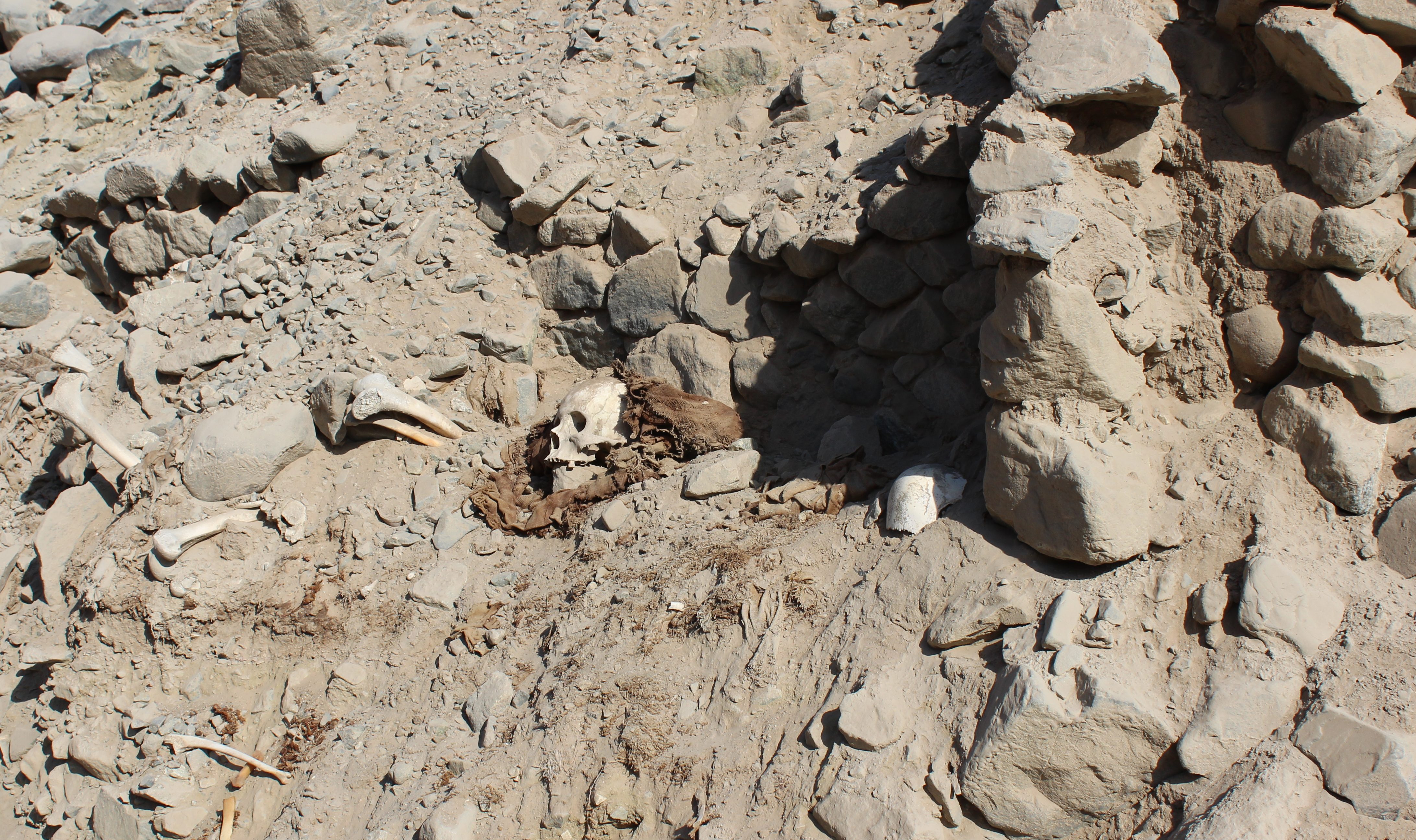
In the second niche there is a human skull, a llama skull, and the bones of a baby, wrapped in cloth.
There are fibres and ropes, some of woven vegetable, others beautifully plaited with cotton cord of varying thicknesses, lying on the slope down to the road.
“Those would have been the cords to tie round the mummy bundles,” explains Mayra. “The bodies would have been squatting, wrapped in cloth and placed in the niche, with a little window so that their descendants could feed them.”
“Someone is still feeding them.”
I point to a plastic bottle of water, placed beside the skull.

Looking about, we realise that the road has cut through the edge of an ancient settlement which extends up the hillside. We can see low walls of buildings, built of small flat stones and plastered with clay. Closer to the road is a small room. Llama bones protrude from the wall, as if they were pegs to hang clothes on. In a niche in the wall are some tiny dried cobs of maize.
Look” cries Mayra, pointing. On the edge of the road is a small scallop shell, pierced at the top to be worn as a pendant.
“This I am going to keep. And wear. Maybe I shouldn’t. Archaeological site and all that. But it is just lying in the road. And maybe they,” she points to the skulls, “would like someone to wear it.”
Junior’s travels
We continue upriver, the valley narrowing now and the road rising higher up the hillside, until it descends again to a plateau of land which falls steeply to the river. A flat roofed brick building stands at the front of a field of stunted trees. Chickens scratch in the dirt beside it. I peer into the room, and a man comes out to greet me, chasing a yapping dog back inside.
“Good afternoon. We have come to see the stone.”
“You are welcome.” He lowers his head and shakes our hands, ” I am Junior. Please, come and see,” and he leads us behind the building.
Rising before us is a great cuboid block of dark stone taller than a man and four times as long. The stone surface shines under the bright dome of the sky. A breeze has begun to blow down the valley.
“You can see it best in the early morning, ” says Junior.
He fetches a broom and sweeps the dust from the face of the stone.
Three lizard figures climb up the face of the boulder, a cluster of beetles moves across the shoulder, on the upper flank is a man holding a tree in one hand and a snake in the other, whilst a serpentine river descends one side, passing close by what appears to be a whale.
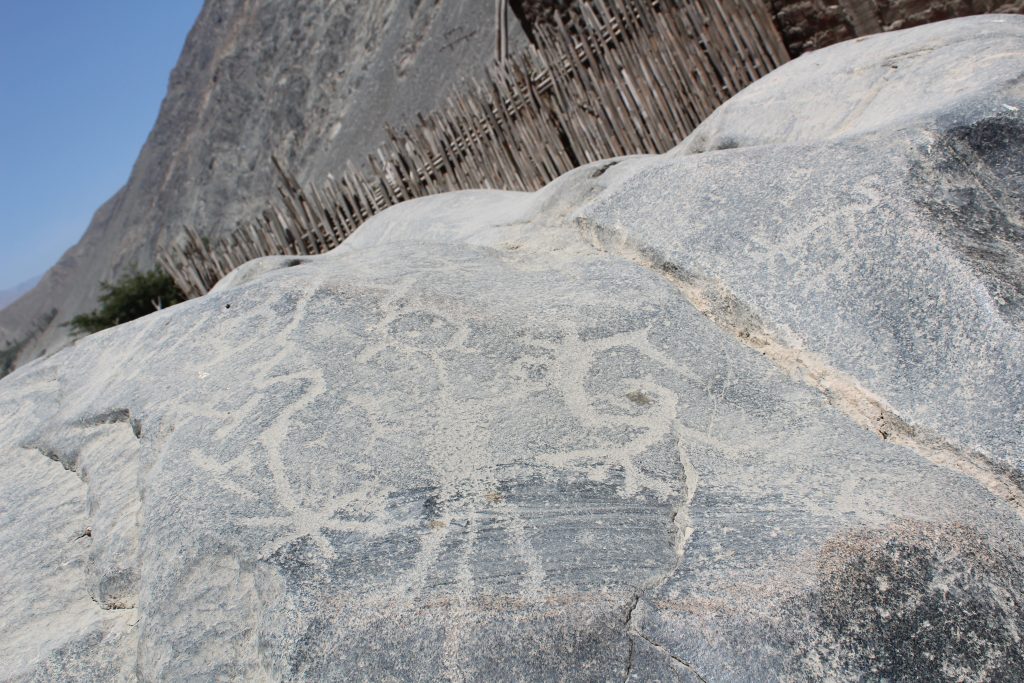
“There is more to see on top,” he says.
I clamber up using the footholds he points out, and reach down a hand to Mayra.
“Come and look!”
There is plenty of room for us to stand side by side on its broad flat top.
The fissured upper surface has more images, including stars, T-shapes, and abstract patterns. There is a group of small round cupules in two lines of eight.
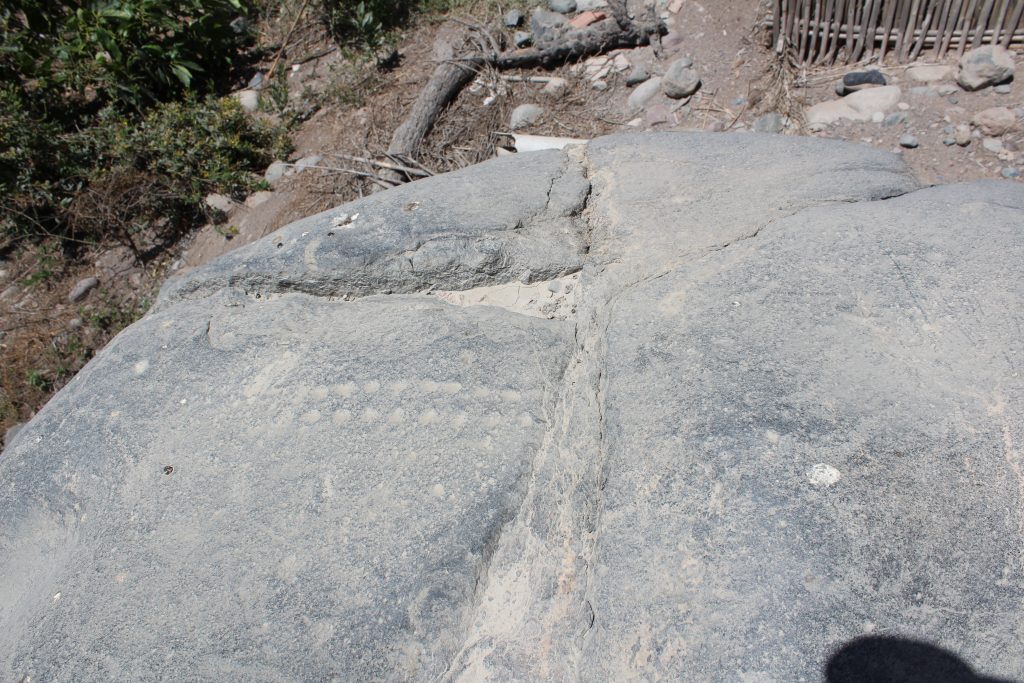
From the top here, we can look down on the valley. The river far below bends to the right, and the road drops steeply. In the distance is a cluster of houses on a shoulder of land. Between that settlement and our position is a broad level area, eight hundred metres upstream, across the river. Great blue-black stones can be seen rising above dwarf fruit trees. That, I imagine, is Cochineros.
We clamber down and sit on old apple crates besides the stone, passing the water bottle and enjoying the light wind which is stirring the branches of the molle tree. I ask Junior what he knows about the stones.
“I have found many things … one time working over there I saw something shiny in the soil. Looking closer, I found a silver figure, this size.” He holds up a calloused black-nailed farmer’s thumb.
“Another time I found a little bag, full of beads. The beads were made of stone, in white and red, blue and green. The bag was woven from vicuña.”
“I used to work for the electricity company,” he continues, “I travelled all around the valley and the highlands, putting up the electric poles. I worked as far as Yauyos. The people there wear silver, lots of silver beads and pins. And they speak their own language.”
“There is a entrance or a cave, and inside I found a stairway which leads to the top of the mountain. And I saw there marks and drawings also, like those you can see here.”
I did not understand everything he was saying, and it was now late afternoon. “I would love to talk more, ” I said, “but we want to go and see the stones on the other side. How do we get there?”
“You can walk to Cochineros in ten minutes. There is a bridge over the river. Give my greetings to Rodrigo!”
We follow the road as it drops from high above the river towards the valley bottom and the riverside, where a path leads between trees and reeds and across sand and boulders to the slow moving waters. We wade ankle deep across to a narrow central island of pebbles and then towards the bridge, which consists of rude logs and branches roped together, stretching to a raised stone in the centre of the river, and then on to the other side. White water rushes over boulders beneath, and the branches bend and twist beneath our feet as we cross, one at a time, trampolining to the other side.

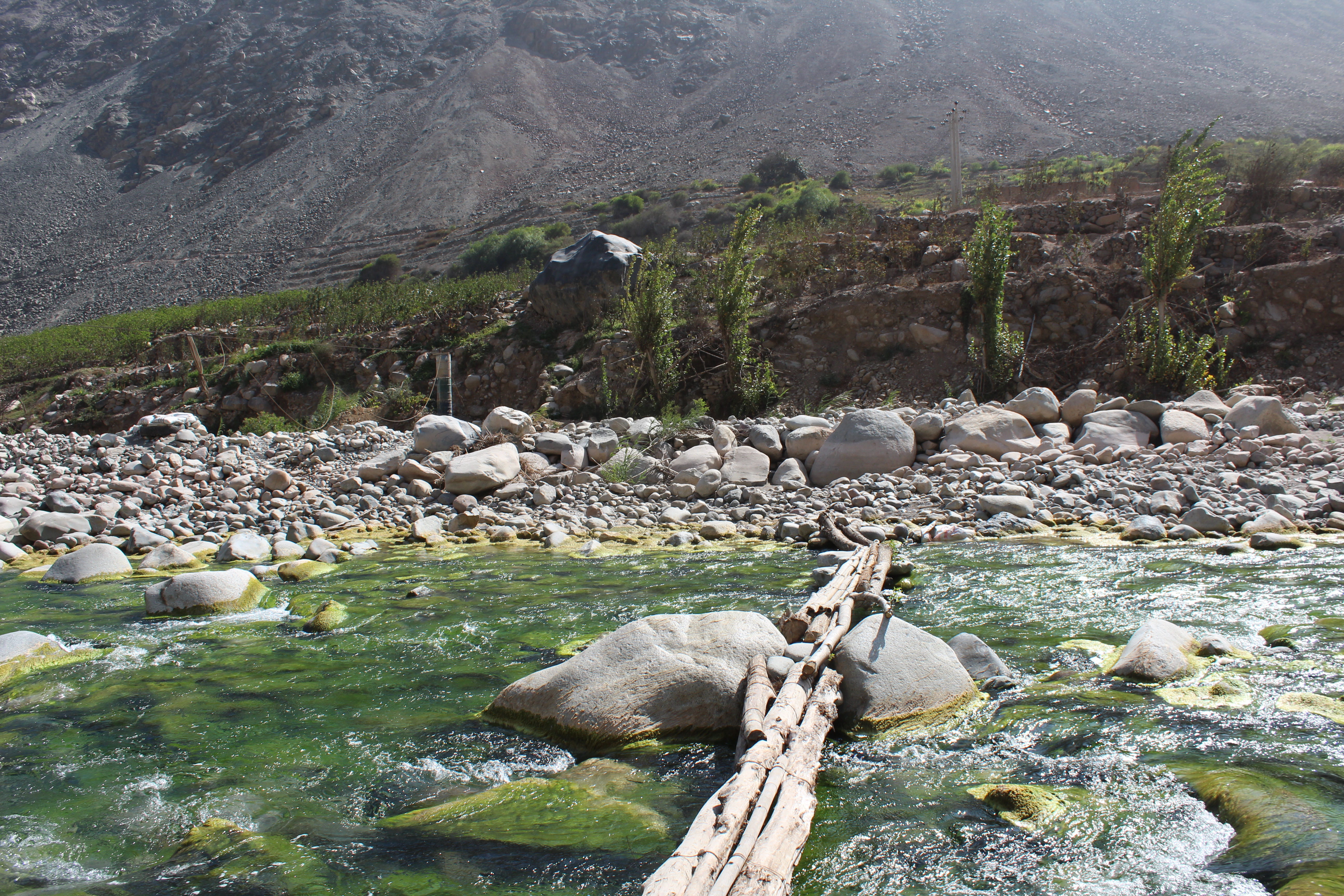

We step off the bridge onto a pretty paved patio, with adobe columns built to support hanging vines. At the upstream end is a thick wall of river boulders as a protection against the waters. Directly ahead, we see the steep frontage of a boulder as big as a cottage. The river has cut away the earth to reveal an angular face six metres high. The top is a steeply sloped roof of grey stone smoothed in ages past by the river.
We cross the patio and clamber up the steep hillside, holding onto the sturdy little apple trees. Now we can walk round the great rounded boulder. The northern side is grey with many indistinct and superimposed motifs. The southern panel is darker and steeper, with some clear bright images and others more faded. There are hundreds of images here, birds, llamas, human figures, geometric designs, and a giant heart, almost a metre wide, inscribed “1964”. On the opposite side, in a similar style, bright white against the rock, are the initials JMJR.


“This is … awesome,” exclaims Mayra. “This one rock, its like a book!”
“It is that, but in a foreign language.”
” Not entirely. Some of these images, I’ve seen on textiles and ceramics. The llama there, the human figure.”
“There are more rocks, according to Amerigo, “twelve, some of them of great size”. Let’s see what we can find.”
An even larger rock, perches on the edge of the upper terrace further downstream. We squeeze through close planted dwarf apples, a little taller than ourselves, their branches at eye height, walking on the ridges between the irrigation furrows which thread between every line of trees, catching occasional glimpses of the rock ahead.
The top is several metres wide, an undulating surface like a folded quilt. There are many images, drawings on top of drawings. The rock is degraded and fractured, slabs and fragments have broken off, some fallen below, others still lying, loose, on the surface, like parts of a jigsaw puzzle. From this flat top the rock flows down in folds, ten metres long. The lower faces are darker, with finely marked drawings in white.
We take photographs of everything we can.
Returning to our starting point, we pass half hidden amongst the apple trees a rounded boulder little more than a metre high, but falling three metres to the lower terrace. The upper corner is dominated by what could be a bearded face or mask with curling lines and circles heading out from the forehead.


Squeezing through to the end of the orchard we cross a stone lined irrigation canal leading diagonally down towards the river. The path drops onto a lower terrace leading to a high black boulder which juts out over the river.
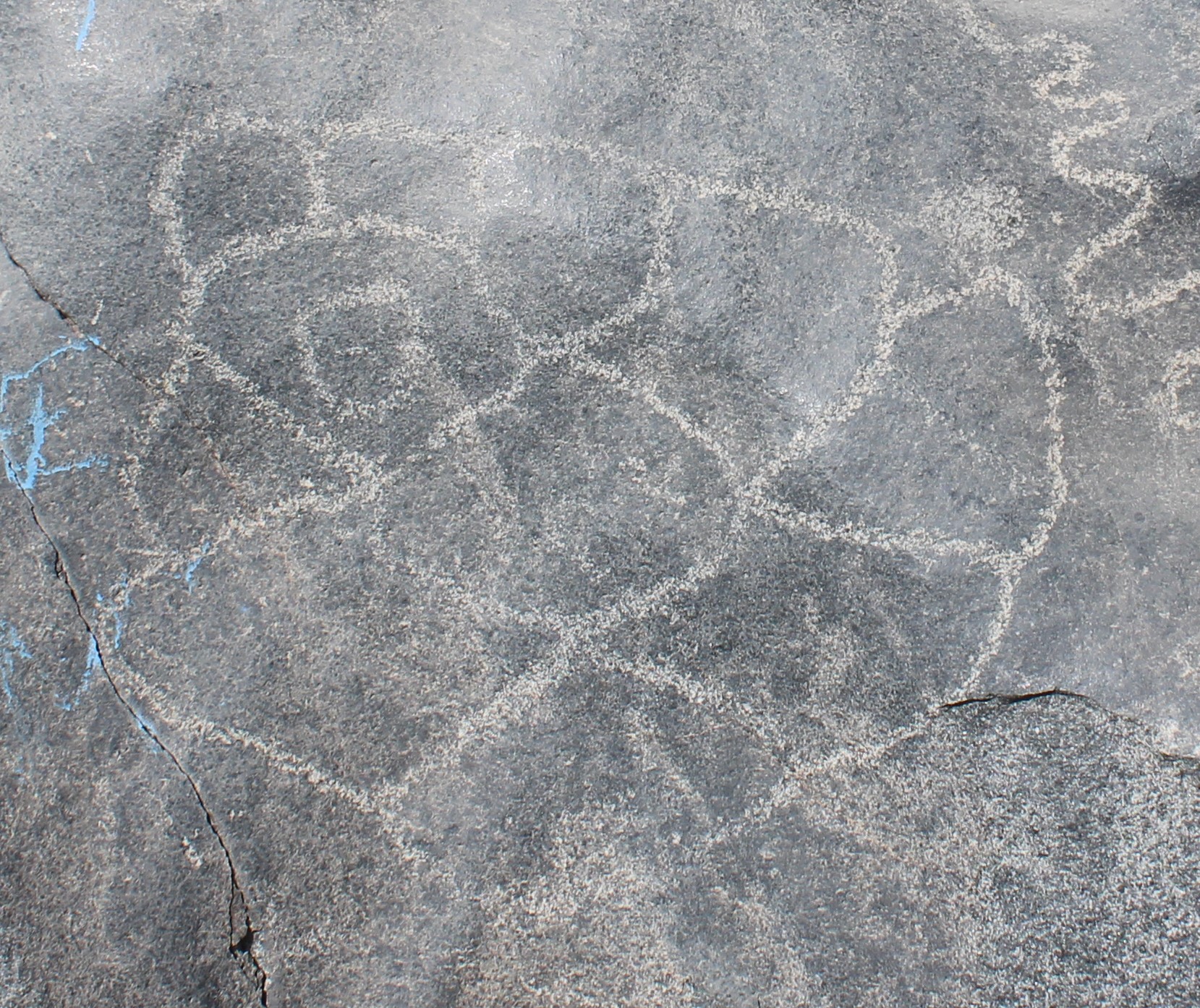
The face of this rock presents a tracery image, apparently abstract, with a serpent form to one side. “Mayra, can you see what that is?”
“Is it a pattern, like a game board?”
“That was my first thought. And then I realised … it’s a parrot!”
“Oh wow. Of course! So beautiful!”
Further on is a low, flat topped boulder. At the river end of the rock, close to a white vein which cuts across the upper surface, is an isolated figure. Sitting by the river alone, his head in his hands, with tendrils of power or hallucination streaming from his head, he looks like a shaman sitting on a stool.


Back on the upper terrace we head past a simple square store room of plywood set in a yard of compacted earth, ringed with boulders. There are no trees here, but a complex of walls, columns and standing stones, on low marshy ground. Behind the storeroom, on the edge of the terrace with a drop to the river, is a hemispherical stone, with a cleaved face, almost vertical, facing towards us.
It can be imagined as a rounded boulder that has split, leaving one flat plane facing south, down river. The face is covered in a myriad of designs, some faint, some clearer and fresher, some finely drawn and others scrawled on roughly, with images drawn on top of earlier images.
Twin peaks
We lunch sitting on a low wall under the shade of a cherry tree, its fruit green and yellow. All around are boulders.
Far up the valley, wisps in a blue sky, are twin white peaks.
A wind rises up from valley, rippling the surface of the blue pool, stroking the glossy black rocks, sighing through the branches of the cherry tree.
I have brought a salad, and fried chicken, and a good red Rioja.
“Mayra, I have been wondering, why did you come to Peru?”
“You could also ask “Why did I go to Venezuela?” because actually I am Peruvian.”
” But…”
” I know, it is easier to let people think I am from Venezuela. And when I experience … sometimes the way people look at me and talk to me, I think to myself “I am not going to tell you I am Peruvian”. But my father took me to Venezuela when I was just ten. In the 1980s.”
“Things were very bad then. We had to queue for bread. Prices would double overnight. So my father decided to go to work in Venezuela.”
“I had three brothers and sisters. And Venezuela was a booming economy, with high quality education. So I find myself in Caracas as a ten year old.”
“At school, people spoke Spanish but it was different. I was different. The children would make fun of my accent. I don’t want to say they were bad, they were just children, and I was only ten, I was too sensitive. But I felt an outsider for many years.”
“But my father got a job, he sent money home, I got an education, my sister came to join us.”
“And…?”
“Well … I will tell you the rest later. Lets look at the stones.”
Giant canvases
Moving upriver the view opens out to a dusty unplanted terrace through which an elevated roadway heads due north. On the left are a series of seven or more rectangles of low level ground, like empty gardens, separated by walls of stone a metre or more wide. On the right the bare rocky ground drops in stages towards the river bed.
Looking ahead the north we see the valley opening out, two great mountain sides descending steeply to the river, whilst a quebrada, a dry ravine, comes in from the right with a low hillside behind stretching towards the centre of the valley.
There are three more great boulders ahead, two close by the roadway, and the third perched above a sharp drop to the river level.
The first is a rounded whale of a rock rising out of the gravel.
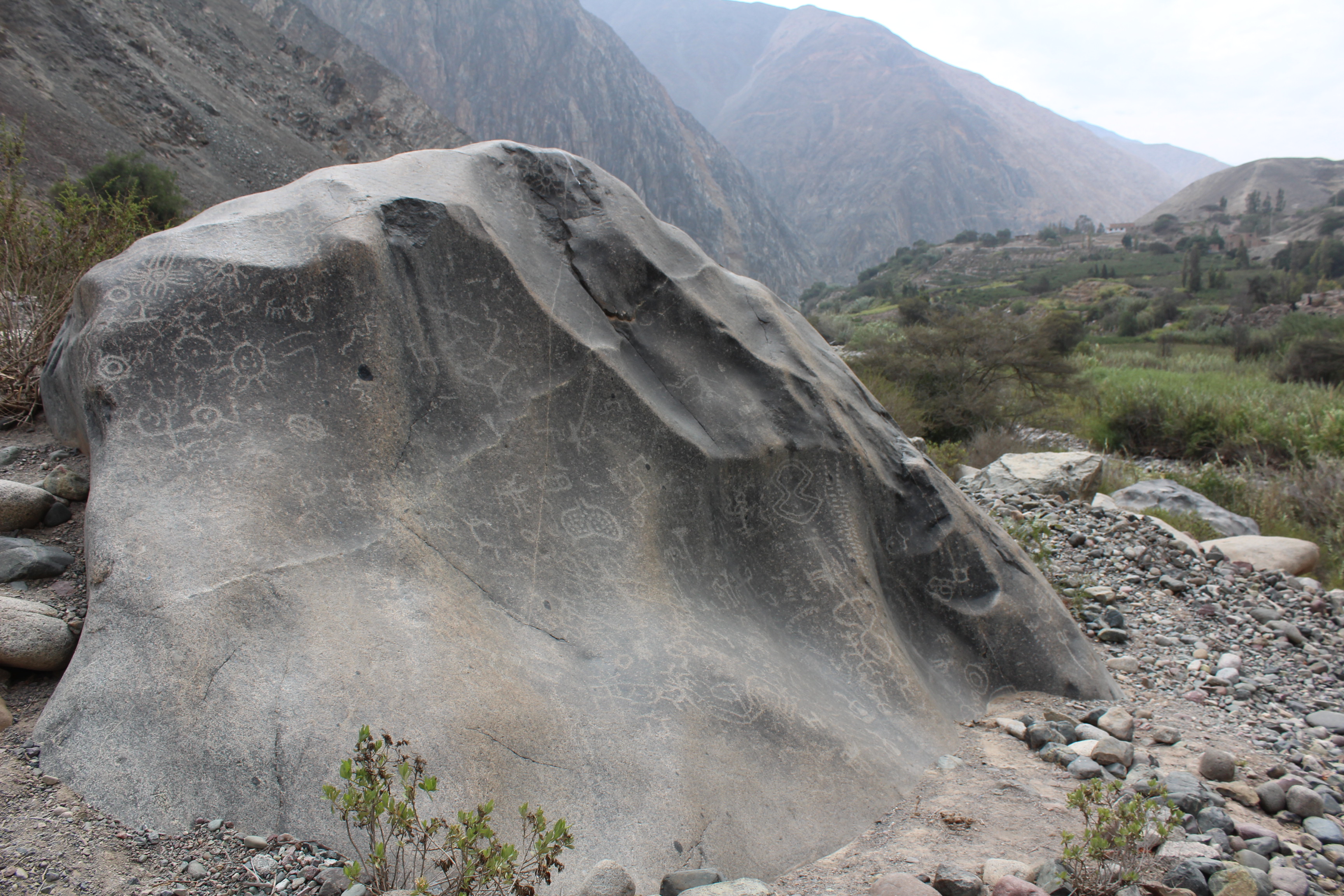
The upper part of the rock, a little below eye level, has complex and finely drawn images centred around a double headed snake figure.

On the northern face, low down on the rock and contouring a little above the sloping ground, we find a group of enigmatic figures, bright and fresh, all done in a similar style.
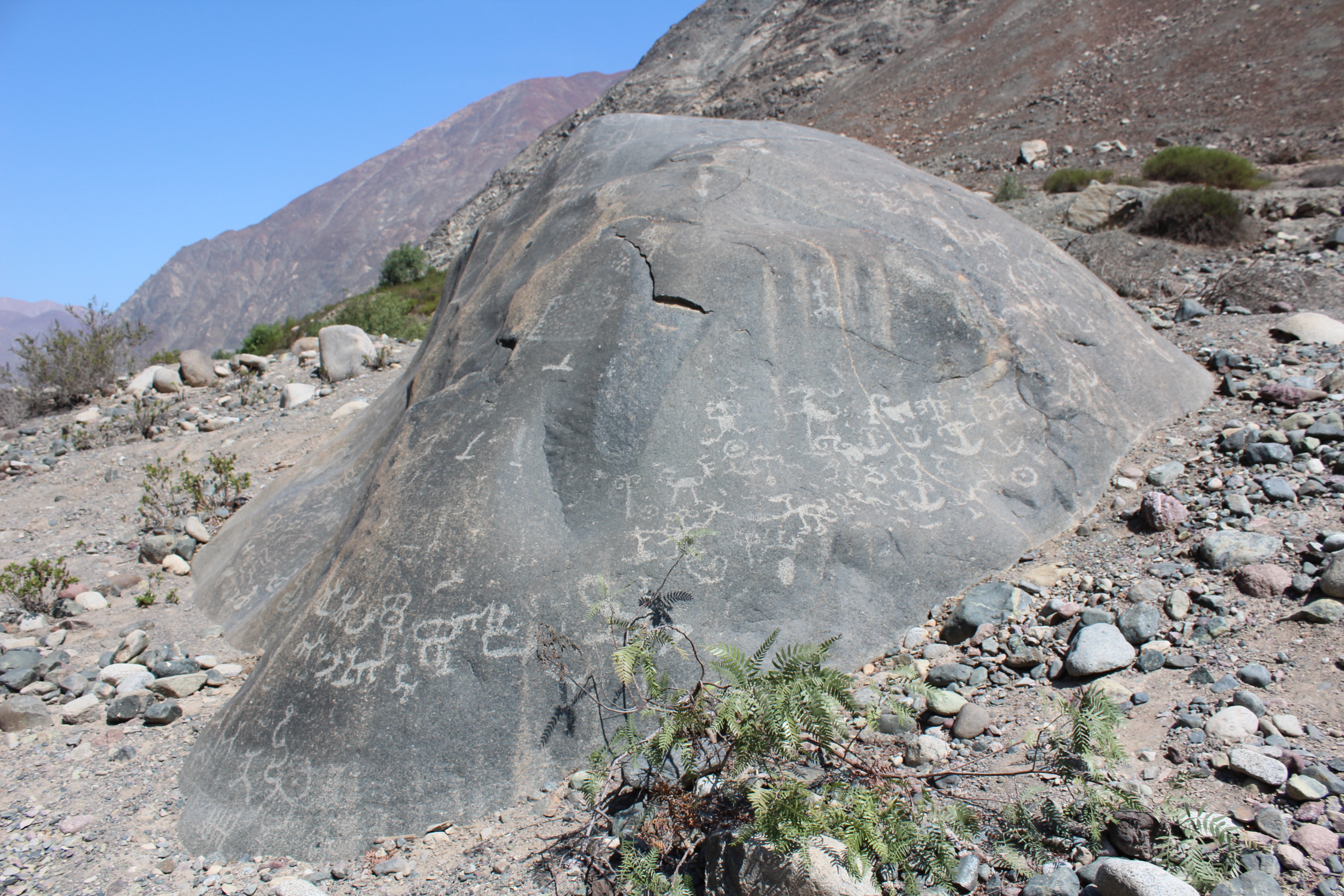
Beyond, a long low rock has been gloriously smoothed by the river, and flows in a series of natural rounded forms. There are several groups of llamas drawn on the upper surface, led by human figures. Some groups are clearly visible, white against the grey rock, whilst another can barely be seen.

There is another great boulder level with the ground on its upper surface but dropping steeply to the terrace below. A group of five llamas of decreasing size, the man holding the first by the nose or neck, faces me as I approach.
We appear to have explored the rocks to their limit, but a little further we find two smooth white river boulders standing upright like door posts at the entrance to a platform. There are signs of human presence here, a series of walls and platforms stepping down towards the river. There are fragments of ceramics on the ground. Walking across the platforms we find the openings to several underground chambers, their oval walls built of river cobble held together with adobe. Whatever they may have once held, they are now clean and empty.

The afternoon is moving on, and we still have several hours walk back down to La Capilla, the tarred road and the last bus. Finally we descend from the terraces and stumble over the bridge. Looking back across the river, I can see five great rocks which dominate the site, which rise up out of the landscape with powerful symbolism. All are of the beautiful blue-black diorite polished by the flowing river. These five, I suspect, are the showpieces of the gallery. But there is much more to see and understand here, and all we have for now is fleeting impressions, two heads full of ideas, and a camera full of images.
Go back…1. To begin in the beginning…
